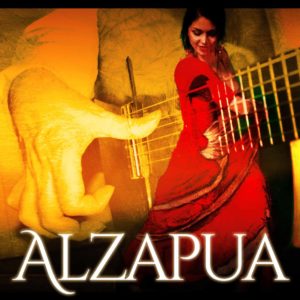FOR SUBTITLED TRANSLATION TO ANY LANGUAGE:
(click 1.) press “CC” button, down on the right side (underlined with a red line – means subtitles ON)
(click 2.) press: “a small gear” button – to the right next to it, and then:
(click 3.) press: “Subtitles CC”, and then:
(click 4.) press: “Auto-translate” – first, and finally:
(click 5.) in the popup menu – select the desired language…
Alzapua is a result of the string instruments technique development over many centuries. It is probably the oldest flamenco technique. All the way from Ziryab’s coming to the Moorish ruled Alhambra, Granada in 822nd, there was already a rich tradition of string instruments and strumming techniques.  The original medieval Arab lute had initially just 4 strings. Some were doubled and was played with a specially carved bone pick. Alzapua is performed with just the thumb, with a very similar movement to the one that was used with the bone stick in medieval times. The Gypsies were the catalyst for the accumulation of the cultural heritage over the centuries, so they become the carrier for the essential information that will form flamenco we know today. As soon as they took a 5 string lute/guitar in the 1674th, and were forced to make the strings of animal intestines – the first flamenco techniques were born. And that crude approach opened new possibilities that guitarists started exploiting for further development. The upward movement with the thumb is one of the examples. But, alzapua technique besides the complex double stroke uses the “golpe” hit, and when performed brilliantly, it makes the guitar sound like there are two guitarists and one percussionist playing…
The original medieval Arab lute had initially just 4 strings. Some were doubled and was played with a specially carved bone pick. Alzapua is performed with just the thumb, with a very similar movement to the one that was used with the bone stick in medieval times. The Gypsies were the catalyst for the accumulation of the cultural heritage over the centuries, so they become the carrier for the essential information that will form flamenco we know today. As soon as they took a 5 string lute/guitar in the 1674th, and were forced to make the strings of animal intestines – the first flamenco techniques were born. And that crude approach opened new possibilities that guitarists started exploiting for further development. The upward movement with the thumb is one of the examples. But, alzapua technique besides the complex double stroke uses the “golpe” hit, and when performed brilliantly, it makes the guitar sound like there are two guitarists and one percussionist playing…
From the beginning of the 19th century in Spain, with the classical guitar coming to the world music stage and being played more and more in the elite society, the Gypsies rapidly adopted this new 6 string instrument as their own. Started populating western Europe from the Punjab province in India during the Moz-Arabs ruled Iberia in the 12th century, many of the Gypsy “guests” remained after the 15th and 16th-century Christian conquests, that started in 1492. Castilla and Toledo’s alliance expelled (almost) all Jews and Arabs, but not all the Gypsies. Besides that fact, the Gypsies were the ones that were the carrier and the catalyst for all right-hand techniques because they were too poor to buy metal strings, like normal citizens. They were making the strings from animal intestines and were playing the guitar without any bone pick, using the fingers and fingernails. They were now traveling nomads again just under Christian rule, and as the second order citizens, Gypsies continued to spread the spirit of freedom over the Iberian peninsula. Their nomadic freedom ideology, under years of repression – created the very essence of the Flamenco spirit and culture we have today…!
Alzapua playing style came from their different approach to this newly emerged and perfected 6 string instrument. Instead of performing it plucking the strings by pulling and releasing them with the fingers (like classical guitarists, which would require a certain level of precision and fingernails hygiene); their approach to it was much cruder. They started using the whole body of the guitar as a percussion instrument, hitting the front board to create sound and playing the “golpe” hit. Therefore paving the way for the “golpe” protection plate to appear. But the most important is that they invented a whole new technique from scratch, hitting the strings with the top of the fingernails with circular repetitive motion; using as a pivot base both the wrist and the finger base joint with the anchored thumb. Therefore creating the base of the “Rasqueada”, as opposed to “Punteada” guitar, (today being the flamenco and the classical guitar).
Flamenco Guitar Lessons reveals secrets, tips, and tricks for mastering flamenco guitar, through a set of very comprehensive video tutorials on Harmony, Techniques, Styles (“Palos”) and Nails. The technically rich Iberian legacy brought every single classical guitar technique into the world of flamenco. That’s why the flamenco guitarists today are on the technical front lines, widening flamenco language and achieving the impossible. On the other hand, the strict classical guitar world, waiting for some piece to be written to embed the technique into the classical guitar heritage, is still late to adopt many fantastic flamenco techniques. Therefore Flamenco Guitar Lessons explores the most important from both worlds.
A special sample player software called Flamenco Loop Player, will enable you to effectively learn flamenco rhythm (compás) by playing along the highest quality flamenco percussion samples of: cajón (hand drum), palmas (claps), shaker, djembe, congas, bongos, maracas…and all the most used percussion instruments in flamenco. Every beat is marked with a yellow vertical line, and every group of beats to consider while counting is highlighted with green, so you can easily understand the accents seeing exactly what is where, and develop an inner feeling for the rhythm…
